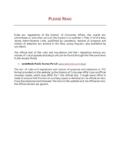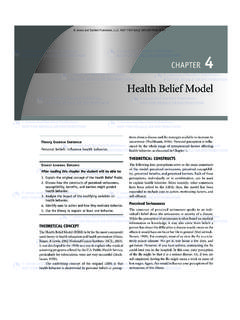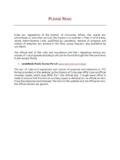Transcription of Scleroderma Education Program Chapter 2 …
1 Scleroderma Education Program Chapter 2. Raynaud's, Finger and Skin Care Chapter 2 - 1. Chapter Highlights 1. Cold Fingers: Raynaud's Phenomenon - Tips to help Raynaud's Phenomenon 2. Skin Problems: Scleroderma and the Skin - Help for Dry Skin - Itching - Color Changes - Skin Ulcers Chapter 2 - 2. This second Chapter usually takes about 20 minutes. Cold Fingers: Raynaud's Phenomenon In the last Chapter we introduced Raynaud's (pronounced RAY -KNOWDS). Phenomenon (see figure on next page). When someone has Raynaud's phenomenon their fingertips change color when exposed to cold temperatures. In general, an attack starts with the fingertips getting very pale, becoming numb and then turning purple or blue.
2 These symptoms can happen within minutes of being exposed to cold temperatures and will last until the fingers get warm again. Sometimes the fingers will turn red as they warm up and there may be a painful throbbing or burning sensation as this happens. Who Gets Raynaud's? Raynaud's phenomenon is a common condition. It affects about 1 out of 20. adults in the United States. Most of these people just have Raynaud's and will never develop Scleroderma or other connective tissue diseases. However, a small percentage of people will go on to develop Scleroderma . In these people the cold sensitivity is called secondary Raynaud's Phenomenon because it is due to the Scleroderma . Most people with Scleroderma do develop this kind of cold sensitivity as the first sign or symptom that something is wrong.
3 What Causes the Symptoms of Raynaud's? A spasm in the small blood vessels in the fingers is what causes a Raynaud's attack. This spasm also causes the color changes. Many people also have Raynaud's attacks in their toes. The color changes of a Raynaud's attack are an exaggeration of what happens normally when hands are exposed to the cold. Everyone will develop cold hands when they are exposed to cold temperatures for a long enough time. However, the normal cold response is a blotchy red and white pattern. The color changes of a Raynaud's attack---white then blue or purple---are very different. Chapter 2 - 3. Raynaud's Phenomenon In Raynaud's, there is The excess collagen of a spasm in the small Scleroderma can happen in the blood blood vessels in the vessel wall and narrow blood vessels.
4 Fingers. This reduces blood flow to body tissues and organs. Most people with Scleroderma will notice changes of color in their hands when it is cold or The fingers turn when they are in stressful situations. first white . then blue . The white color is caused by the lack then red. of blood flow. The blue color is a sign that the fingers are not getting enough oxygen. At the end of the attack the fingers turn red. This signals that the blood is flowing back to the fingers in a rush. Chapter 2 - 4. Tips to Help Raynaud's It is easier to prevent a Raynaud's attack than to stop it once it has started. So . ? Protect your fingers and toes from cold temperatures. This is the best way to prevent Raynaud's.
5 ? Keep your whole body warm---not just your hands. ? Consider it cold outside if it's 65 degrees or lower. When the temperature or wind chill outside fall below 65. degrees wear protection on your hands. ? Wear mittens instead of gloves. Remember that mittens keep your hands warmer than gloves. Chemical hand warmers are helpful. ? Try to avoid sudden changes in temperature. Shifting temperatures may make things worse such as going from a warm outside temperature to cool air conditioning. ? Be careful, even in warm weather. The winter months aren't the only time to be careful of cold temperatures. Other cold things can trigger a Raynaud's attack. ? Seek peace. Stress or nervousness can make the response to cold worse.
6 THINGS THAT CAN TRIGGER A. RAYNAUD'S ATTACK. 1. Cold air, INCLUDING air conditioning 2. Holding a cold drink 3. Washing something in cold water 4. Reaching into the refrigerator or freezer Chapter 2 - 5. Keep Gloves Everywhere! Keep gloves in your kitchen when you have to reach into the freezer. Take gloves to the grocery store where the frozen food aisles may trigger attacks. Keep gloves in your desk at your office or at home. Keep Your Whole Body Warm Bring extra layers of clothing when you are going somewhere that might be cold. Use a space heater in the bathroom or at your office at work if it gets too cold. Get your bed warmed up. Stay warm at night by preparing your bed ahead of time.
7 Warm it up with an electric blanket or hot water bottle. Flannel sheets are warmer than regular ones. Have your car warmed up and ready to go before you leave the house. If you don't have a loved one to do this for you, think about a remote car starter. A lambskin steering wheel cover will help protect your hands from cold temperatures when you drive. Chapter 2 - 6. Reduce Stress in Your Life Stress can trigger an attack. Stress can also be a trigger for Raynaud's attacks. Stress causes the blood vessels in the fingers to get smaller so that more blood goes to large muscles in the arms and legs. This helps the body prepare for the stressful event but may cause a Raynaud's attack.
8 Learn to control stress. Learning relaxation and stress management skills may help decrease stress-related Raynaud's attacks. Pay attention to the things that cause stress and Raynaud's attacks. Try to prepare for them. Medications Can Help Your doctor may prescribe medication that helps with Raynaud's (see Table 1). The most common medications are called vasodilators. The calcium channel blockers are the most effective vasodilators for Raynaud's Phenomenon. Calcium channel blockers are commonly used for blood pressure control or angina (heart vessel spasms). They also stop the spasms of arteries in Raynaud's Phenomenon. Other vasodilators can be used including topical nitroglycerin cream.
9 For severe Raynaud's Phenomenon with digital ulcers (discussed later in this Chapter ) intravenous prostaglandins are given. Biofeedback May Help Biofeedback has been shown to be helpful in treating primary Raynaud's. Biofeedback uses a machine to give you information on the temperature of your hands. A biofeedback therapist can teach you skills for increasing blood flow and warming the temperature of your hands. Biofeedback machines can help you become more aware of small changes in the temperature of your fingers and what works to prevent attacks. Biofeedback will be discussed more in Chapter 8. Chapter 2 - 7. Table 1: Medications to Prevent or Reduce Raynaud's Symptoms MEDICATION BASIC MECHANISM PRINCIPAL SIDE.
10 EFFECTS. CALCIUM CHANNEL BLOCKERS. Nifedipine (Procardia, Adalat) Relaxes blood vessels - Low blood pressure Diltazem (Cardizem, DilacorXR) - Constipation Veropamil (Calan, Isoptin) - Nausea Nicardipine (Cardene) - Increased trouble Bepridil (Vascor) swallowing Isradipine (DynaCirc) - Lightheadedness Amlodipine (Norvasc) - Headache Nisoldipine (Sular) - Fluid retention OTHERS. Prazosin (Minipress) Relaxes blood vessels - first dose low Terazosin (Hytrin) blood pressure Doxazosin (Cardura). Pentoxifylline (Trental) Enhances blood flow to - Nausea skin - Dizziness Carbaprostacyclin (Lloprost) Relaxes blood vessels, - Nausea Investigational for Scleroderma inhibit platelets - Loose stools - Flushing - Jaw discomfort Nitroglycerin ointment Relaxes blood vessels - Headache - Flushing Chapter 2 - 8.




